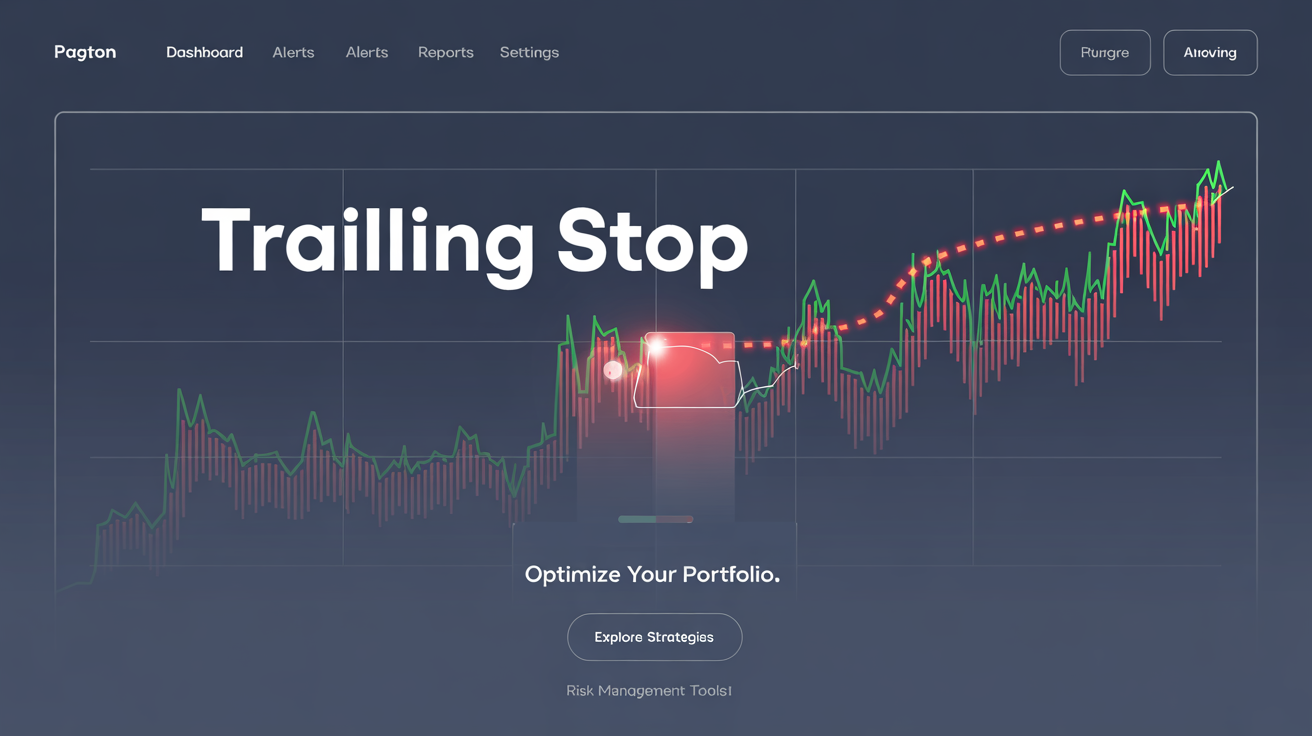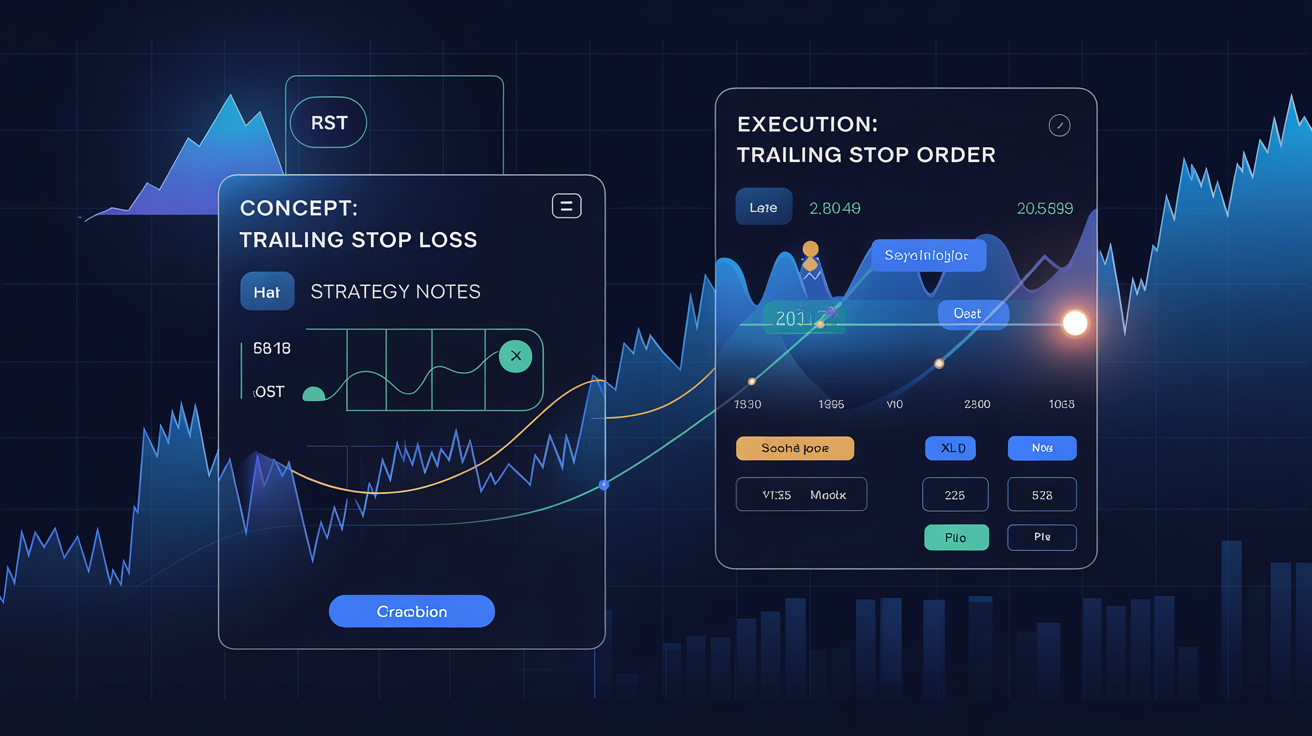Trailing Stop Loss Explained: Lock in Profits and Limit Risk

Most traders obsess over the perfect entry, but the real winners? They master the exit. That’s where the trailing stop loss comes in. Think of it as your silent bodyguard, locking in profits as your trade climbs higher, and stepping in when he second momentum shifts.
No more staring at charts 24/7 or panicking over every dip. Whether you’re flipping stocks or riding crypto waves, a trailing stop loss can help you stay in control, protect your gains, and cut losses before they spiral. Yet, too many traders ignore this simple tool — and end up watching their hard-earned profits vanish.
Understanding the basics of the stock market can make tools like trailing stops feel less intimidating and more essential.
In this guide, you’ll learn how trailing stops work, why they’re a secret weapon for smart traders, and exactly how to set them up to maximize your trading success without the stress.
What Is a Trailing Stop Loss and Why Traders Should Care

Many traders use stop-loss orders to limit losses. But a trailing stop loss is more advanced—it moves with your trade as prices go up and stays put when prices fall.
If you’re new to trading, understanding how to buy and sell stocks lays the groundwork for mastering advanced strategies like trailing stops.
Unlike a regular stop-loss that stays at one fixed price, a trailing stop moves higher as your position gains value. It “trails” the current price by a set distance. This distance can be a dollar amount or a percentage.
Let’s say you buy Ethereum at $2,000 and set a 10% trailing stop loss. If ETH rises to $2,500, your stop moves up to $2,250. If the price drops from there, your position sells automatically at the stop price, locking in a $250 profit.
A lot of beginners ignore this because they either don’t understand how it works or think it’s too complex. But this tool is powerful because it lets your trade grow while still protecting your downside.
How a Trailing Stop Loss Works in Trading & Crypto
Now that you understand what a trailing stop loss is, it’s time to dive deeper into how it works. This strategy is used in both stocks and cryptocurrencies to manage risk and protect gains.
If you’re actively trading, especially short-term, exploring stock trading techniques can further refine your exit strategies.
Whether you’re trading traditional stocks or the more volatile crypto assets, a trailing stop order can be an excellent tool for maintaining control over your positions. This section will explain the basic mechanics of a trailing stop order and how it functions in real-world trading situations.
The Basics of a Trailing Stop Order
A trailing stop order is a type of stop-loss order where the stop price is dynamically adjusted as the market price increases. The stop price is set at a fixed amount below the market price—either in terms of a dollar amount or a percentage. This allows the stop price to rise as the asset price increases, ensuring that you capture profits without exiting too early.
For example, if a trader sets a percentage-based trailing stop loss at 10%, the stop-loss will move up 10% below the highest price the asset reaches. If the price increases from $100 to $150, the stop-loss level will adjust accordingly. If the price drops back to $135, the trailing stop order is triggered, and the position will be sold.
There are two common ways to set a trailing stop loss:
- Dollar-based: This method sets the trailing stop at a specific dollar amount below the highest price the asset reaches.
- Percentage-based: This method sets the trailing stop at a certain percentage below the highest price.
What Happens When Prices Move Up or Down
When the price of the asset increases, the trailing stop loss follows the price, maintaining the set distance. For example, if a stock goes from $100 to $150, and a trader has set a trailing stop at 10%, the new stop-loss will be $135. If the price continues to rise, the stop-loss moves up, locking in profits.
However, if the price starts to drop, the trailing stop loss will remain fixed. If the price falls to $135, the stop-loss will be triggered, and the position will be sold. This allows the trader to exit the trade before the price drops significantly, preserving profits.
Traders often make the mistake of adjusting their trailing stop loss too frequently. If they change their stop levels based on short-term price fluctuations, they risk exiting a profitable trade too soon. It’s important to allow the trailing stop loss to follow the natural movement of the market while maintaining a safe distance from the price.
Why Trailing Stop Loss Is a Core Risk Management Tool
A trailing stop loss is more than just a tool to lock in profits—it is an essential part of any effective risk management strategy. It helps traders manage the downside risk while also giving the trade room to grow.
In this section, we will discuss why the trailing stop loss is an indispensable risk management tool and how it helps traders avoid emotional decision-making and lock in profits without micromanaging their trades.
It Helps Traders Avoid Emotional Decisions
The psychological aspect of trading is often underestimated. Loss aversion—the fear of losing money—can lead traders to make impulsive decisions. They may hold onto losing trades for too long or sell prematurely to avoid further losses. A trailing stop loss helps eliminate the emotional component of trading by automatically adjusting to market movements.
When traders use a trailing stop loss, they no longer need to worry about constantly monitoring the market or second-guessing their trades. The stop-loss adjusts based on price movements, ensuring that the trader doesn’t exit too early or too late. This enforces discipline, allowing traders to follow their trading plan without being influenced by emotions.
It Locks in Profits Without Micromanaging the Trade
For swing traders and long-term holders, the trailing stop loss is a perfect tool for locking in profits while reducing the need to micromanage every trade. With this tool, you can allow a trade to grow naturally while protecting profits if the market reverses.
In the crypto market, where volatility is often high, the trailing stop loss provides traders with the flexibility to stay in a trade longer, catching potential profits while safeguarding against downturns. For example, during a rally in Ethereum, a trailing stop loss will allow you to stay in the position as the price increases, while protecting your profits once the price starts to drop.
How to Set a Trailing Stop Loss Like a Pro

Setting a trailing stop loss properly is crucial for effective risk management. Whether you’re trading stocks or cryptocurrencies, understanding the mechanics behind setting a trailing stop order can help you lock in profits and protect against downside risk.
If you’re looking to diversify your approach, learning different investment strategies can sharpen your trailing stop techniques even further.
Percentage vs Dollar-Based Trailing Stops
When setting a trailing stop loss, traders have two options: using a percentage-based or dollar-based stop. Each method has its pros and cons, and the choice depends on the asset you’re trading and your risk tolerance.
- Percentage-based trailing stops are often preferred in markets with high volatility, like cryptocurrency, because they adjust dynamically with the asset’s price.
- Dollar-based trailing stops are more suited for less volatile markets like stocks because they provide more control over the amount at risk.
The key is to match the stop method with the volatility of the asset you’re trading. For example, in a highly volatile crypto market, a 10% trailing stop may be more appropriate, while a tighter dollar-based stop may be more effective for stable stocks.
Matching Volatility to Stop Settings
The volatility of the asset should play a significant role in determining your trailing stop loss level.
If you’re trading larger indices like the S&P 500, recognizing the volatility can help you decide how tight or loose your stops should be.
Cryptocurrencies, for example, experience large price swings, so setting a tight trailing stop can lead to premature exits. Stocks with lower volatility can benefit from a tighter stop-loss.
One way to adjust the trailing stop based on volatility is by using Average True Range (ATR) or moving averages.
In the crypto market, when volatility is high, you may need to set a looser trailing stop to avoid being stopped out too early during natural price fluctuations.
Planning Your Trade with a Trailing Stop Loss

Professional traders don’t wing it. They plan every move, including the exit. A trailing stop loss should be part of that plan from the start.
Use It as Part of a Bigger Trading Plan
Before you buy, know where your trailing stop will be. This keeps you calm and in control.
Let’s say you buy Apple at $150 and set a 5% trailing stop. If it goes to $170, your stop moves to $161. If it reverses, you exit with a gain.
This setup works in stocks, options, futures, and crypto.
Pairing Trailing Stop Loss With Take-Profit Orders
Many traders use both: a take-profit target (like 20%) and a trailing stop (like 10%). That way, they maximize gains when prices pop but also lock in profit if the price drops.
This combo gives you more control and helps avoid “greedy trader” mistakes.
Trailing Stop Loss vs Trailing Stop Order: Know the Difference

These two terms are often confused. Let’s fix that.
The Mechanics Behind Each Order Type
- Trailing stop loss is the idea that you define how it works.
- Trailing stop order is how your trading app or broker executes it.
Understanding broker execution is crucial, especially when selecting the right platforms. Beginners might find it useful to explore the best brokerage accounts for beginners to ensure they can properly use trailing stop features.
When you set a trailing stop loss, the platform uses a trailing stop order to make it happen. Knowing this difference helps you understand your tools better and avoid order mistakes.
When to Use a Trailing Stop Loss in Trading
Trailing stops work best in trending markets. They help you ride the wave and exit before the crash.
1. During Trending Markets or High Volatility
If you’re trading a coin during a bull run, use a wide trailing stop. You can ride the trend and avoid a big reversal.
Traders interested in maximizing volatile market opportunities might also want to learn about zero-day options (0DTE), another strategy involving quick market moves.
Example: If Avalanche jumps from $40 to $55, a trailing stop helps you exit if it dips back to $50. You still walk away with gains.
2. Avoid Using It in Sideways Markets
If prices aren’t moving much, trailing stops can backfire. You might get stopped out often, even if your trade is good long-term.
In flat markets, consider fixed stop-loss orders instead, or wait for a trend to form.
Risk of Using a Trailing Stop Loss Too Tight
Trailing stops are helpful, but they’re not perfect.
1. Avoid Premature Exit Traps
If you set your stop too close to the current price, it’ll trigger on small dips. This often happens to beginners who use 2% or 3% stops on assets that move 6% daily.
Developing patience is key — and in broader portfolio management, understanding best ways to invest money can help balance aggressive trading tactics with longer-term strategies.
Give the asset space to move. The goal is to catch the trend, not sell at the first shakeout.
2. Flash Crashes and Platform Errors
Especially in crypto, flash crashes can cause price dips that hit your stop, then bounce back. This can be frustrating.
Also, not all platforms handle trailing stops the same way. Always check if your exchange supports trailing stop orders and how they behave during fast market moves.
Trailing Stop Loss in Crypto Trading: Is It Safe?

Yes, but only when used right. Crypto moves fast. A coin can go up 10% in an hour and fall 12% the next. That’s why trailing stops are great here, but also risky if set wrong.
For altcoins, wider stops (like 15%–20 %) are safer. For larger coins like Bitcoin or ETH, 5%–10% usually works.
Avoid using trailing stops during major events (like exchange news or regulation updates). These can cause big price swings that trigger your stop and leave you out of the bounce.
Final Thoughts
Mastering the art of the exit is what separates surviving traders from thriving ones, and the trailing stop loss is one of the sharpest tools you can have in your arsenal.
It gives you the freedom to let your profits run while still guarding your downside, removing emotion from your decisions and keeping you disciplined through every market swing.
If you’re also working toward better financial habits overall, planning using strategies like the 50/30/20 rule for budgeting can complement your trading discipline by keeping your entire financial life in balance.
Whether you’re trading fast-moving crypto or steady stocks, knowing how to set the right trailing stop can be the difference between locking in gains or watching them slip away.
It’s not about guessing the top; it’s about protecting your growth smartly and consistently.
Start practicing with trailing stops, refine your settings based on volatility, and make it a regular part of your trading plan. Because in the long run, those who protect their wins are the ones who stay in the game — and win bigger.
